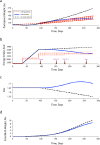Control systems engineering for optimizing a prenatal weight gain intervention to regulate infant birth weight
- PMID: 24832411
- PMCID: PMC4056194
- DOI: 10.2105/AJPH.2014.301959
Control systems engineering for optimizing a prenatal weight gain intervention to regulate infant birth weight
Abstract
Objectives: We used dynamical systems modeling to describe how a prenatal behavioral intervention that adapts to the needs of each pregnant woman may help manage gestational weight gain and alter the obesogenic intrauterine environment to regulate infant birth weight.
Methods: This approach relies on integrating mechanistic energy balance, theory of planned behavior, and self-regulation models to describe how internal processes can be impacted by intervention dosages, and reinforce positive outcomes (e.g., healthy eating and physical activity) to moderate gestational weight gain and affect birth weight.
Results: A simulated hypothetical case study from MATLAB with Simulink showed how, in response to our adaptive intervention, self-regulation helps adjust perceived behavioral control. This, in turn, changes the woman's intention and behavior with respect to healthy eating and physical activity during pregnancy, affecting gestational weight gain and infant birth weight.
Conclusions: This article demonstrates the potential for real-world applications of an adaptive intervention to manage gestational weight gain and moderate infant birth weight. This model could be expanded to examine the long-term sustainable impacts of an intervention that varies according to the participant's needs on maternal postpartum weight retention and child postnatal eating behavior.
Figures



References
-
- Institute of Medicine and National Research Committee to Reexamne IOM Pregnancy Guidelines. Weight Gain During Pregnancy: Reexamining the Guidelines. Washington, DC: National Academic Press; 2009.
-
- Gunderson EP, Abrams B. Epidemiology of gestational weight gain and body weight changes after pregnancy. Epidemiol Rev. 1999;21(2):261–275. - PubMed
-
- Amorim AR, Rossner S, Neovius M, Lourenco PM, Linne Y. Does excess pregnancy weight gain constitute a major risk for increasing long-term BMI? Obesity (Silver Spring) 2007;15(5):1278–1286. - PubMed
-
- Siega-Riz AM, Viswanathan M, Moos MKet al.A systematic review of outcomes of maternal weight gain according to the Institute of Medicine recommendations: birthweight, fetal growth, and postpartum weight retention Am J Obstet Gynecol 20092014339e1–e14 - PubMed
Publication types
MeSH terms
Grants and funding
LinkOut - more resources
Full Text Sources
Other Literature Sources
Medical

